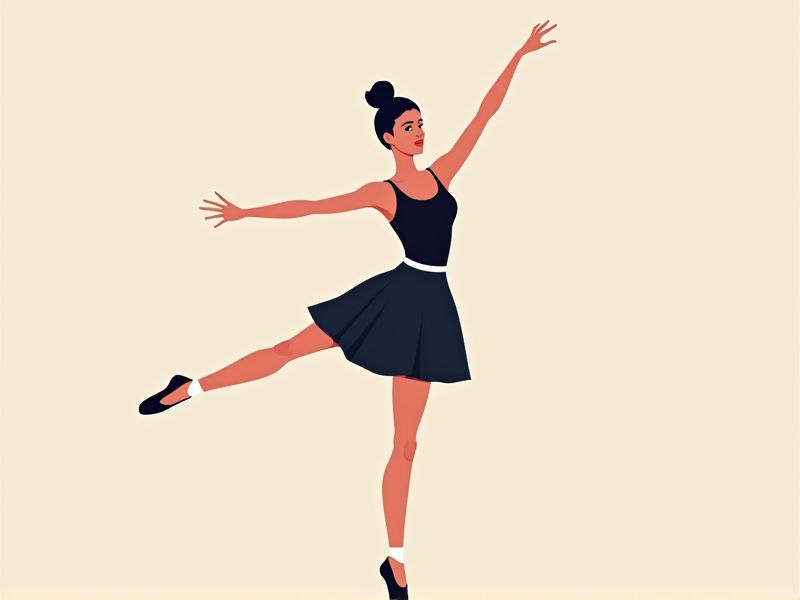
To excel in ballet, one must focus on mastering the fundamentals with diligence, as Samuel Johnson noted, "What we hope ever to do with ease, we must first learn to do with diligence" . This emphasis on diligent practice is echoed by Rudolf Nureyev, who famously said, "When I miss class for one day, I know it. When I miss class for two days, my teacher knows it. When I miss class for three days, the audience knows it" . Suzanne Farrell also highlighted the importance of discipline, stating that her goal was to be the best dancer she could be, not the most famous, which led to great freedom and calm . By combining these principles, dancers can refine their technique and performance quality.
How to Be Better at Ballet
Technique mastery
Focusing on consistent posture and alignment practice ensures your foundation is strong, making each movement more precise. Breaking complex routines into slow-motion drills isolates muscle memory, allowing you to correct flaws before they become habits. Supplementing your ballet practice with targeted strength and flexibility training supports the execution of intricate steps without compromising technique. Regular feedback from experienced instructors pinpoints areas for improvement, accelerating your progress through corrective measures.
Consistent daily practice
Consistent daily practice cultivates the muscle memory needed to perform ballet movements with precision. Daily sessions improve posture and alignment, reducing injury risk through gradual conditioning. Regular practice allows for measurable progress as small improvements accumulate over time. This routine builds both physical endurance and mental focus, crucial elements for mastering complex dance routines.
Enhanced flexibility training
Enhanced flexibility training is a vital component for refining your ballet technique and executing intricate positions effortlessly. Incorporate targeted stretching routines that mix dynamic movements with static holds to boost your range of motion progressively. Design a consistent weekly schedule that emphasizes stretching key muscle groups like the hamstrings, hip flexors, calves, and back muscles to meet ballet's physical demands. Gradually integrate advanced techniques such as PNF stretches to further enhance flexibility and build the strength needed for more graceful, precise performance.
Strength conditioning routines
Incorporating strength conditioning routines into your ballet practice builds a data-backed foundation for enhanced muscle support and precise control. Targeted exercises like weighted squats, lunges, and core workouts lead to measurable improvements in stability and endurance, essential for executing challenging ballet moves. Progressive overload techniques and plyometric drills further boost power and resilience, reducing injury risks and increasing overall performance. Monitoring and adjusting your training intensity using performance data ensures that your strength conditioning effectively complements your ballet technique for optimized results.
Proper alignment focus
Consistent focus on proper alignment forms the foundation for fluid, injury-free ballet performance. Studies in kinesiology emphasize that maintaining a straight spine and engaged core during movement improves balance and minimizes strain. Concentrating on these key physical cues during practice can result in measurable improvements in technique and precision. Regularly integrating targeted alignment exercises and expert feedback into your routine ensures a data-driven approach to refining your ballet skills.
Mindful body awareness
Mindful body awareness sharpens the connection between your mind and muscles, enabling precise adjustments to posture and alignment during ballet movements. Focusing on each physical sensation as you transition through positions helps you identify and correct imbalances. This deliberate concentration on movement details enhances proprioceptive feedback, which in turn reduces the risk of injury and improves execution. Incorporating mindfulness techniques into your training routine leads to more controlled, graceful, and expressive performances on stage.
Core strength development
Developing core strength enhances stability during complex ballet movements, reducing the risk of falls and injuries. A strong core directly improves balance and alignment, which are essential for graceful, controlled execution of dance techniques. Incorporating exercises like planks, Pilates, and targeted abdominal workouts into your routine at least three times a week yields measurable improvements in posture and endurance. Data shows that dancers with a robust core experience a notable boost in performance, enabling them to execute precise movements with increased confidence.
Engagement with expert coaching
Expert coaching identifies and corrects subtle technical deficiencies, which bolsters a dancer's form and precision, laying a stronger foundation for advanced ballet techniques. Personalized guidance from experienced instructors can rapidly accelerate skill development by focusing on an individual's unique challenges and strengths. Regular coaching sessions also provide constructive feedback that refines posture, balance, and movement flow, reducing the risk of injury and promoting longevity in training. The structured discipline and tailored strategies derived from expert mentorship directly contribute to improved performance, artistic expression, and overall ballet proficiency.
Expressive performance style
Focus on precise technical alignment and fluid transitions, as this creates a solid foundation for expressive movements. Regularly use video feedback and mirror practice to identify subtle nuances in your performance that can communicate emotion more clearly. Incorporating daily improvisation exercises helps integrate emotion with technique so each move tells its own story. Analyzing feedback from professional mentors allows you to adjust your approach and consistently elevate the expressive quality of your ballet performance.
Injury prevention strategies
A consistent pre-warmup routine that includes dynamic stretching helps prepare muscles and joints for intensive ballet movements, reducing strain and injury risk. Correct technique and proper alignment, reinforced through expert feedback, prevent repetitive stress injuries and ensure efficient movement execution. Strength-conditioning and cross-training exercises enhance support around critical joints, enabling dancers to perform complex maneuvers with reduced risk of overuse injuries. Paying close attention to bodily signals and allowing sufficient recovery time minimizes the buildup of fatigue, warding off long-term harm and ensuring sustainable progress.
Summary
Mastering technique is the cornerstone of ballet, as precise movements directly translate to improved performance and expression. Consistent daily practice reinforces muscle memory and solidifies skills, leading to observable, quantifiable progress over time. Enhanced flexibility training contributes to a greater range of motion, reducing injury risks and boosting overall agility. Together, these elements create a compounded effect that significantly elevates a dancer's proficiency and artistry in ballet.
